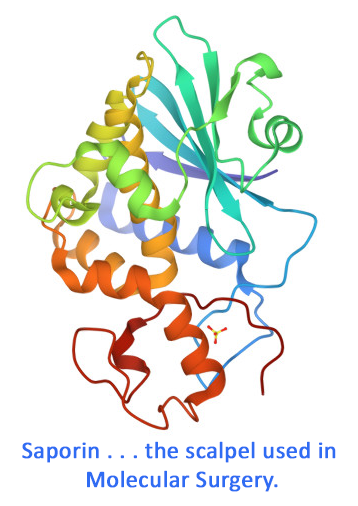The GM1 (Galactosyl-N-Acetylgalactosaminyl) receptor is found on cells such as motoneurons, sympathetic pre-ganglionic neurons, astrocytes as well as cells in the intestinal epithelium. Cholera toxin B (CTB) binds the GM1 receptor and administration of CTB-SAP causes ablation of the specific cells expressing the receptor. CTB-SAP can be used to create a model of respiratory motor neuron death to establish an animal model of Amyotrophic lateral sclerosis (ALS), otherwise known as Lou Gehrig’s disease. This model also demonstrates that CTB-SAP is retrogradely transported. Intrathecal injection of CTB-SAP results in elimination of oligodendrocytes and astrocytes as well as supporting the study of demyelinating conditions.
CTB-SAP is a chemical conjugate of cholera toxin B-subunit and the ribosome-inactivating protein, saporin. It specifically eliminates cells expressing the GM1 receptor, including preganglionic neurons, motoneurons, and astrocytes.
U.S. Patent 6.376,460 “Method of Modulating Cellular Activity” protects methods of peripheral injection of subjects using this neuronal tracer. Before using these methods please contact Flinders Technologies Pty. Ltd. for license information. flinderstech@flinders.edu.au
CTB-SAP is available individually (Cat. #IT-14) or as a kit (Cat. #KIT-14) which includes CTB-SAP and Saporin (Cat. #PR-01).
keywords: GM1 receptor, Cholera Toxin B, ALS, Amyotrophic lateral sclerosis, animal model, lou gehrig’s disease, retrograde transport, astrocytes, demylelinating, oligodendrocytes, motoneurons , preganglionic neurons, brain, neuroscience
Mitigating the functional deficit after neurotoxic motoneuronal loss by an inhibitor of mitochondrial fission
Ciuro M, Sangiorgio M, Cacciato V, Cantone G, Fichera C, Salvatorelli L, Magro G, Leanza G, Vecchio M, Valle MS, Gulino R (2024) Mitigating the functional deficit after neurotoxic motoneuronal loss by an inhibitor of mitochondrial fission. Int J Mol Sci 25(13):7059. doi: 10.3390/ijms25137059 PMID: 39000168
Objective: To use the Cholera Toxin B-Saporin (CTB-SAP) mouse animal model of Amyotrophic lateral sclerosis (ALS) to determine the efficacy of mitochondrial division inhibitor 1 (Mdivi-1) for its potential neuroprotective effect.
Summary: Mdivi-1 reduced motor deficits in the ALS model. It also showed neuroprotective effects on motoneurons and promoted plasticity. This could represent a translational approach for motoneuron disorders.
Usage: To establish the model, mice received two injections of the retrogradely transported, ribosome-inactivating toxin, CTB-SAP (Cat. #IT-14) into the medial and lateral right gastrocnemius muscles, respectively, with a toxin dose of 6 μg/2 μL in PBS per injection.
Related Products: CTB-SAP (Cat. #IT-14)
Saporin as a commercial reagent: its uses and unexpected impacts in the biological sciences-tools from the plant kingdom
Ancheta LR, Shramm PA, Bouajram R, Higgins D, Lappi DA (2022) Saporin as a commercial reagent: its uses and unexpected impacts in the biological sciences-tools from the plant kingdom. Toxins (Basel) 14(3):184. doi: 10.3390/toxins14030184 PMID: 35324681
Summary: Saporin is a ribosome-inactivating protein that can cause inhibition of protein synthesis and causes cell death when delivered inside a cell. Development of commercial Saporin results in a technology termed ‘molecular surgery’, with Saporin as the scalpel. Its low toxicity (it has no efficient method of cell entry) and sturdy structure make Saporin a safe and simple molecule for many purposes. The most popular applications use experimental molecules that deliver Saporin via an add-on targeting molecule. These add-ons come in several forms: peptides, protein ligands, antibodies, even DNA fragments that mimic cell-binding ligands. Cells that do not express the targeted cell surface marker will not be affected. This review will highlight some newer efforts and discuss significant and unexpected impacts on science that molecular surgery has yielded over the last almost four decades. There are remarkable changes in fields such as the Neurosciences with models for Alzheimer’s Disease and epilepsy, and game-changing effects in the study of pain and itch. Many other uses are also discussed to record the wide-reaching impact of Saporin in research and drug development.
Read complete article.
Hypoglossal motor neuron death via intralingual CTB-saporin (CTB-SAP) injections mimic aspects of amyotrophic lateral sclerosis (ALS) related to dysphagia
Lind LA, Murphy ER, Lever TE, Nichols NL (2018) Hypoglossal motor neuron death via intralingual CTB-saporin (CTB-SAP) injections mimic aspects of amyotrophic lateral sclerosis (ALS) related to dysphagia. Neuroscience 390:303-316. doi: 10.1016/j.neuroscience.2018.08.026
Objective: Despite its fundamental importance, dysphagia (difficulty swallowing) and strategies to preserve swallowing function have seldom been studied in ALS models.
Summary: The authors report a novel experimental model using intralingual injections of cholera toxin B conjugated to saporin (CTB-SAP) to study the impact of only hypoglossal motor neuron death without the many complications that are present in ALS models.
Usage: Hypoglossal motor neuron survival, swallowing function, and hypoglossal motor output were assessed in Sprague Dawley rats after intralingual injection of either CTB-SAP (25 ug) or unconjugated CTB and SAP (controls) into the genioglossus muscle.
Related Products: CTB-SAP (Cat. #IT-14)
Adenosine 2A receptor inhibition promotes neuroprotection following toxic insult to phrenic motor neurons.
Sajjadi E, Seven YB, Simon AK, Zwick A, Satriotomo I, Mitchell GS (2019) Adenosine 2A receptor inhibition promotes neuroprotection following toxic insult to phrenic motor neurons. FASEB J 33(1):844.3. Experimental Biology 2019 Meeting Abstracts doi: 10.1096/fasebj.2019.33.1_supplement.844.3
Objective: The authors explored the role of A2A receptors in phrenic motor neuron cell death in vivo.
Summary: A2A receptors, which contribute to motor neuron death during toxic insults, are upregulated in spared phrenic motor neurons of CTB-SAP treated rats. This is an important finding since A2A receptor upregulation may accelerate motor neuron death in neurodegenerative diseases like ALS.
Usage: CTB-SAP selectively killed nearly all phrenic motor neurons within a week and caused diaphragm paralysis (p<0.01).
Related Products: CTB-SAP (Cat. #IT-14)
browse all references for this product | back to top


Reviews
There are no reviews yet.